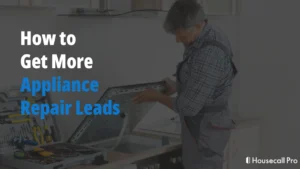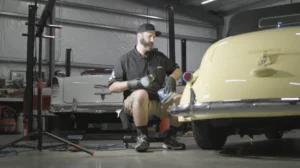Want to win more jobs with less effort?
Grow your business and send quick quotes with our home service software.

Car detailing can be a profitable business with steady demand from everyday drivers and car enthusiasts alike. Getting your pricing right means knowing your local market, understanding how complex each job is, and paying attention to what customers expect. Price too low, and you undervalue your skills. Price too high, and potential clients might go elsewhere.
This guide walks you through average car detailing prices across the U.S., the main factors that affect rates, common types of detailing services, and tips to help you set prices that are fair, competitive, and profitable.
- Average car detailing prices at a glance
- How to price your car detailing services
- Mobile detailing pricing considerations
- Average car detailing prices by service type
- Add-on services and upsell opportunities
- Building car detailing packages and bundles
- How to raise your car detailing rates without losing customers
Average car detailing prices at a glance
According to CARFAX, basic car detailing costs between $100 and $200 for a small car, while larger vehicles cost an additional $50–$100.
Across the U.S., average service ranges are:
| Service Type | Price Range |
| Interior detail | $100–$350 |
| Exterior detail | $50–$350 |
| Full detail (interior and exterior) | $150–$500+ |
Car detailing rates also vary by vehicle size. Here’s a look at what you might expect to charge:
| Vehicle Size | Price Range |
| Small vehicles (coupe/hatchback) | $50–$175 |
| Mid-sized vehicles (sedans/SUVs) | $175–$250 |
| Large SUVs/trucks | $225–$400 |
| Extra-large SUVs/vans | $500–$650+ |
Rates may vary by region, service complexity, and add-on services. You can use these industry averages as a guide and then tailor your rates to reflect your expertise, cover expenses, and make a profit.
Read more: How to start a car detailing business
How to price your car detailing services
To help price your car detailing services, you can use this simple formula that covers both labor and overhead costs while leaving room for profit:
(Labor hours × hourly rate) + material costs + overhead + markup = customer price
Implementing this formula involves five steps. We’ll walk through each step with clear examples so you can plug in your figures and set the right rate.
Step 1: Choose how you’ll charge
Your pricing method can make or break your bottom line. So, nail this down first before pricing your services. There are three main pricing methods to choose from:
- Per hour: An hourly rate multiplied by the total hours you spend per project. Best if most of your jobs vary, and you want your rate to reflect the actual time spent.
- By car size: Fixed price by vehicle type (small, medium, or large). Best if you want simple, predictable pricing that is easy to understand.
- Flat rate by service: Charge by service type, such as interior, exterior, or engine bay detailing. Factor in the project complexity, cost, and time involved. Best if you offer different services and want an easy menu-style setup.
Each pricing method has pros and cons. With hourly pricing, you’re covered no matter how long a job takes, but some customers don’t like how much bills can vary. Flat-rate pricing is great to build trust since customers know exactly how much they’ll pay upfront. However, if a job needs more effort or time than expected, that extra time comes straight out of your pocket.
Pro tip: If you offer mobile car detailing services, factor in travel time and fuel costs. These expenses eat into your profits.
Step 2: Determine your labor costs
To keep your rates fair and profitable, put a dollar figure on every hour you spend working:
- Single detailer: Hourly rate × number of hours
- For example: $25 × 3 hours = $75 labor cost
- Multiple detailers: Hourly rate × number of workers × number of hours
- For example: $25 × 4 detailers × 3 hours = $300 labor cost
According to ZipRecruiter, a car detailer earns an average of $16.17 per hour. You don’t have to charge that exact amount, but it’s a baseline to compare against.
A good way to set your rate is to track a week’s worth of jobs. See how long each service or car type takes and then average those times. That way, you’re building prices on real numbers instead of guesswork.
Step 3: Add your material costs
Your rates need to cover the supplies you use on every job. Start by listing out all the materials you need, including cleaners, conditioners, waxes, towels, pads, and even disposable gloves. Then, divide the cost of each item by the quantity you use per job.
Here’s an example of how to break down the per-job costs of different materials:
| Product | Item Cost | Quantity Used | Cost Per Bob |
| Interior cleaner | $80 (32 ounces) | 1/4 bottle | $20 |
| Leather conditioner | $40 (16 ounces) | 2 ounces | $5 |
| Carnauba wax | $40 (8 ounces) | 1 ounce | $5 |
| Microfiber towels | $30 (pack of 12) | 2 pieces | $5 |
Your material costs should also factor in safety requirements. The Occupational Safety and Health Administration (OSHA) mandates the safe handling of chemicals, which means you’ll have worker education and training expenses. So, add these to your business costs.
Pro tip: Include taxes and shipping costs, too. These costs add up quickly.
Step 4: Factor in overhead
You can’t ignore overhead costs. Rent, insurance, and employee pay aren’t optional, and the IRS treats them as core business expenses. Add them when calculating your rates.
Overhead costs are grouped into two broad categories:
- Fixed overhead: These costs stay the same regardless of job volume or complexity. Examples include shop rent and insurance.
- Variable overhead: These costs vary with the number of jobs you do. Examples include marketing costs that scale by job.
Once you have these figures, plug them into this formula to calculate your overhead rate:
(Total monthly overhead ÷ total monthly sales) × 100 = overhead %
For example:
Suppose your monthly overhead is $3,000 and you have monthly sales of $10,000.
$3,000 overhead ÷ $10,000 sales = 30% overhead
Let’s apply this to our example, where:
- Labor cost per detailer = $75
- Material costs = $35
- Labor + materials = $75 + $35 = $110
- Overhead = 30% of $110 = $33
The total cost for this example would be:
Labor ($75) + materials ($35) + overhead ($33) = $143
As a best practice, review your overhead rate every quarter. You might be surprised how small costs creep into your profits.
Step 5: Apply markup to set your profit margin
Markup is the amount you add to your cost price to make a profit, while margin is the profit as a percentage of the selling price.
Say you add a 20% markup to your cost price, the selling price of your car detailing service would be:
$143 + $28.60 = $171.60
Here, you have a 16.67% margin ($28.60 ÷ $171.60).
Pro tip: Track metrics like your close rate (how many quotes turn into booked jobs) and the average ticket size (your per-job revenue) to know how profitable your price is.
Simple pricing formula with real-world example
Here’s how your car detailing pricing would look when you put the pieces together:
- Labor: 3 hours × $25 per hour = $75
- Materials: +$35
- Overhead: +$33
- Subtotal: $143
- Markup: 20% of $143 = $28.6%
- Customer price: $171.6 for a profitable full interior detail
Plug in your own figures to run the same calculations and price your services with confidence. Or, use Housecall Pro’s Price Book to set and standardize your rates, allowing you to save time on every quote.
Read more: How to calculate markup and margin
Mobile detailing pricing considerations
Running a mobile detailing business comes with extra costs. You need to pay for fuel, extra travel time, wear and tear on your vehicle, and mobile setup supplies like water tanks or generators. To stay profitable, factor those costs into your rates.
Many detailers either charge a per-mile travel fee or set a minimum service charge. For example, if a 20-minute drive adds up to 40 minutes round-trip, calculate labor and overhead costs for that time to keep margins intact.
Because mobile detailing is convenient, customers expect to pay slightly more.
Pro tip: Use a service plan template for mobile detailers to build consistent pricing that factors in travel time, fuel, and mobile setup costs.
Average car detailing prices by service type
Auto detailing prices often depend on the service a customer chooses. Here’s a quick look at how much you can charge:
- Full interior detailing: $100–$350
- Exterior detailing: $50–$350
- Full-service packages: $150–$500+
Add-on services and upsell opportunities
Specialized upgrades can increase revenue. Here are some upsell opportunities and suggested price ranges:
- Ozone odor removal ($70–$150): Uses an ozone generator to get rid of tough smells.
- Clay bar treatment ($100–$150): Lifts embedded dirt and grime, leaving the paint smooth and ready for waxing.
- Paint correction ($200–$1,000): Erases scratches and swirl marks.
- Headlight restoration ($50–$150): Clears up foggy headlights to improve nighttime visibility.
- Ceramic coating ($500–$2,000): Adds a protective layer that prevents UV rays from fading the paint.
Get In Touch: 858-842-5746
Let us earn your trust
On average, Pros increase monthly revenue generated through Housecall Pro by 50% after their first year.
See plan options and feature breakdown on our pricing page.
Building car detailing packages and bundles
Packages give customers simple, clear choices instead of a long list of services. This speeds up the decision-making process and encourages repeat business, while you boost your average ticket.
What is price bundling?
Price bundling means offering related services at a single price that is often lower than the cost of buying them individually.
This tactic works because it:
- Makes it easy for customers to see what they are paying for
- Encourages customers to upgrade to higher packages
- Reduces haggling and speeds up the booking process
- Gives customers more value for their money
Exterior detailing package pricing
An exterior detailing package costs $50–$350 and usually includes these services:
- Hand wash and dry
- Tire dressing
- Wax or sealant application
- Wheel and tire cleaning
- Window and mirror cleaning
Interior detailing package pricing
Interior detailing package pricing ranges between $100 and $350 for the following services:
- Dashboard cleaning
- Deep cleaning carpets, floor mats, and trunk
- Deep stain removal
- Interior glass cleaning
- Leather repair or conditioning
- Mold or mildew removal
- Trim restoration
- Vacuuming carpets and seats
Full car detailing package pricing
The average price of full car detailing hovers between $150 and $500 for interior and exterior deep cleaning. This package also includes:
- Clay bar treatment
- Deep cleaning of vents, steering, console, and doors
- Full body carnauba
- Glass, engine, and tire polish
- Removing pet hairs
- Steam engine cleaning
- Treatment for strong odors
What is tiered pricing?
Also known as “good, better, best” pricing, tiered pricing lets you offer a service at different price points, with each tier providing additional features and benefits.
Here is an example of how to set price tiers based on vehicle size:
| Package | Small cars | SUVs | Trucks | Services | Use cases |
| Basic (Good) | $50 | $80 | $120 | • Exterior wash • Quick vacuum | Quick, affordable cleaning |
| Standard (Better) | $100 | $150 | $200 | • Full interior cleaning • Exterior wash and wax | Regular maintenance cleaning |
| Premium (Best) | $200 | $300 | $400 | • Full interior and exterior detail • Engine bay wash • Headlight restoration • Ceramic coating | High-end care or resale preparation |
How to present packages and bundles to customers
How you present your packages is just as important as what you charge. Here are some helpful tips:
- Use side-by-side pricing tables on your website or quote sheets so customers can compare options.
- Highlight the middle option as “most popular” to guide customers toward it.
- Train your staff to recommend the premium package first, then step down if needed.
With field service software from Housecall Pro, you can create Good, Better, Best packages to boost your average ticket.
How to raise your car detailing rates without losing customers
Raising your rates might seem risky, but sometimes it’s your only way to stay profitable while delivering high-quality services. The key is knowing when to make the move and helping customers understand why.
Signs it’s time to increase prices
Here are a few signs your rates may be too low:
- Overbooked schedule: You’re constantly booked out weeks in advance.
- Low profit margins: Expenses eat into your revenue and reduce profitability.
- High customer demand: You have a steady stream of repeat customers.
- Rising material or labor costs: Your costs have increased, but your selling price hasn’t.
- Competitors charge more: Similar businesses in your area have higher rates.
To protect your margins, track key metrics like your average ticket size, hours spent per job, and material costs over a 2-4 week period. By spotting patterns, you can confidently adjust your rates while staying competitive.
Need help tracking costs and profitability across jobs? Use Housecall Pro’s job costing software to monitor job performance and adjust your pricing with real-time data.
Communicating rate changes with customers
Tell your customers why you’re increasing your rates, and give them notice before it takes effect. This reduces frustration and preserves customer loyalty.
These auto detailing marketing tips can help you communicate a price hike professionally:
- Email announcement: Give existing customers notice 1–2 weeks in advance and emphasize that service quality remains intact.
- Signage or invoice notes: Add a brief update on invoices, in-shop notices, or online booking tools.
- Social media updates: Share a post on Facebook, Instagram, X, or TikTok explaining the improvements behind the price increase.
Instead of focusing on the new price, emphasize quality and added value.
Success story: How one detailer grew revenue 44% with Housecall Pro
Brandon and Erika Rivera, co-founders of Shine Coat Auto Detailing, increased their monthly revenue from $4,500 to $8,000 per month by streamlining their operations with Housecall Pro. Instead of switching between Google Calendar for scheduling and Square app for payments, they managed everything from customer data to booking and invoicing with Housecall Pro’s all-in-one software.
The shift saved time and gave the duo the confidence to raise prices from $25 to $50 per service. And because Housecall Pro made the customer experience feel smoother, clients stayed loyal.
Ready to grow your car detailing business like Brandon and Erika? Start a free 14-day Housecall Pro trial today.
FAQ
-
How much do car detailers make per car?
-
Most car detailers earn between $100 and $250 per job, depending on vehicle size, package, and add-on services.
-
How much should I pay my detailing employees?
-
Pay at least the national average of $16.17 per hour. Then, increase wages if the employee takes on specialty work or brings repeat business. A competitive rate will help to attract and retain good workers.
-
How do I handle discounts or promotions?
-
Use discounts and promotions sparingly. Reward loyal customers, run seasonal deals, and give limited-time offers, but don’t undercut your base pricing.
-
Where can I learn more about professional detailing standards?
-
The International Detailing Association website offers training programs, certifications, and industry best practices.





